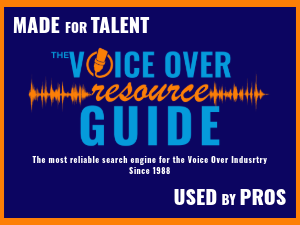|
ISDN - Still 'The' Big League Standard.
Do You Need It? The Tech & Costs ...
Voice actor Dave Courvoisier, who is also the evening news anchor at KLAS-TV in Las Vegas, was asked by friends at RainRecording to write about ISDN - a technology for transmitting quality voice-overs in real time via telephone. His overview is reprinted here, with permission.
By Dave Courvoisier
Voice Actor & TV News Anchor
 ISDN is old technology. Yes, in this age of rapid-fire changes, 1980’s technology qualifies as “ancient”. ISDN is old technology. Yes, in this age of rapid-fire changes, 1980’s technology qualifies as “ancient”. But like the dragonfly, evolution has yet to improve on its function, so it persists.
ISDN stands for “Integrated Services Digital Network”, or sometimes as “Integrated Subscriber Digital Network”... although some might say it stands for: “I’m So Darn Networked” or “Innovations Subscribers Don't Need”.
This telephonic standard for transmitting studio-quality audio over copper wire is such a stalwart in the business of voice acting that it’s considered a must-have for the voice actor truly determined to crack into the upper-crust of best-paying voice jobs.
STILL 'THE' STANDARD
“Not true!” some might say. First of all, there’s some mighty fine quality IP voice transmission mechanisms being offered now, and besides, plenty of voice actors have a lucrative business without ISDN.
On both counts, those arguments are true. Yet ISDN persists as a higher-echelon epitome for those who aspire to the top-of-the-line voice opportunities.
Why?
At HOME OR OFFICE
You could argue that ISDN is a dinosaur, that’s it’s disappearing from the audio landscape, that it’s hard to work with, and that today’s voice actor doesn’t need it.
Still ... ISDN persists.
ISDN can be routed through your house or business much like a regular analog phone line on ordinary paired copper wires, but it allows digital transmission of voice and data through circuit-switched telephone networks that also provides access to packet-switched networks.
It’s much more complicated than that, but we’re not here to give a technical treatise, and the bottom line is that ISDN gives the user superior voice quality over distance, when compared to analog.
REAL WORLD REALITY
OK, that’s all fine and good. Now let’s face the reality of ISDN in real-world application.
It’s fringe. Even phone companies don’t seem that familiar with it. When you call and ask the sales associate at your local phone company about ISDN, a typical answer is: “..you mean DSL?...”.
So part of the challenge of launching into ISDN is dealing with the lingo and finding someone (usually ‘a’ person) in the elusive department within the major telco’s who actually understand what it is.
Those challenges are so daunting to many voice actors, that entire cottage industries have sprung up to hand-hold the neophyte through the process.
You’ll find two of them mentioned in links at the bottom of this article.
THE EQUIPMENT
For the voice actor, tech-savvy or not, the basic set-up requires (in layman’s terms):
1) Installation of the paired copper lines to the studio.
2) Acquisition of an ISDN “box” or codec.
3) Connecting telephone wires and microphone in the proper configuration.
4) Lots of patience with the phone company.
HOW MUCH $$??
And the cost?
A hardware codec can range in price from $3,000 to $7,000.
Installation can vary widely in price according to geographic area and the phone company that services that area. $150 is a ballpark.
ISDN almost always involves a monthly subscription fee, much like your POTS (Plain Old Telephone Service) system, and here, too, the costs seem to run the gamut: $50 to $150.
IN BIG LEAGUES
Evidence the headache and frustration typically experienced in getting all components to talk to each other AND the phone company, and you can see why not just every wayward voice actor is rushing forward with dollars in hand to get on the list of ISDN users.
In fact, no one talks about it much, but ISDN is the threshold that separates the men from the boys in voice acting. It’s tantamount to tech-snobbery. “Oh! You have ISDN?” (implied keys to the club).
SHOULD YOU GET IT?
Now, let’s add the factor alluded to before about ISDN being “disappearing” technology. Does the budding voice actor at least ASPIRE to buying ISDN at some point (much like they might plan to have an agent or join the union)?
Or does the combination of cost, difficulty of configuration, and impending obsolescence argue against it?
Major studios offering the big-ticket voice job possibilities will often make ISDN a basic qualification for even AUDITIONING with them.
At this point, the decision quickly becomes a chicken-or-the egg propositioN - even a Catch-22. Should Yossarian get ISDN because it will possibly bring him more high-paying jobs? Or should Yossarian wait until he’s offered a high-paying job possibility before getting serious about acquiring ISDN?
The deep-pocketed but unaccomplished voice actor with ISDN may never get to use it. Conversely, the talented but financially-strapped voice actor may be missing opportunities to jump to the big league by NOT having ISDN.
This is where personal priorities, goals, practicality, and dollars collide. There is no pat answer.
SOFTWARE HELP
Luckily, a technological solution has presented itself here as well.
A British company will sell you an AudioTX Communicator package of software that lets your computer handle all the heavy-lifting that a codec ‘box’ would normally perform. Cost of purchase and installation: about $1400.
This is almost affordable for some who balked at the cost of a standard codec.
AudioTX Communicator still requires:
There is some other minor hardware esoterica involved, and some software configuration, but done right, AudioTX works darn good.
SOURCE-CONNECT ALTERNATVE
A brief mention here, too, of IP solutions to transmission of studio quality audio signals. This seems to be the next-gen standard.
ISDN codecs offer this as an option. So does AudioTX.
In addition, a company called Source-Elements sells a software-based solution called Source-Connect (for about $400) that requires no phone lines, no codec, no subscription and promises to deliver ISDN-like studio-quality audio over a broadband IP connection.
MORE SOLUTIONS ...
Some services will “bridge” an IP signal into an ISDN signal for a fee.
That means, they’ll take an incoming IP audio source, translate it into an ISDN connection, and send it on to another ISDN codec. These seem a little more stable.
If SKYPE ever gets good enough, it could verge into this market. Some voice actors and studios are using SKYPE now for ‘scratch’ recordings, not the final cut.
Here are additional ISDN resources to check out:
Digital dial-up list and directory of ISDN users:
Ednet, an ISDN services provider:
www.ednet.net/audio/index.html ISDN presents the ultimate technological challenge to today’s voice actor. Some are up to it, some befuddled by it. But in today’s brave new world that marries talent to technology for voice acting success, it’s a challenge more are considering.
Dave Courvoisier (“pronounced just like the fine cognac, only no relation”) is an Emmy Award-winning broadcaster, writer, producer, voice actor, and the main weeknight news anchor on KLAS-TV, Channel 8, the Las Vegas CBS affiliate. He also writes “Voice-Acting in Vegas,” a daily blog of adventures and observations in a style that’s true to his friendly Midwestern farm roots.
Email: CourVO@CourVO.com Web: http://www.courvo.com/ Blog: http://www.courvo.biz/ TV bio: KLAS-TV bio link |
Tell Us What YOU Think!
Please Note: Since we check for spam, there will be a slight delay in the actual posting of your comment.
Comments
No comments have been posted yet. Hurry, and you could be the first!


.png)






click for new article alerts